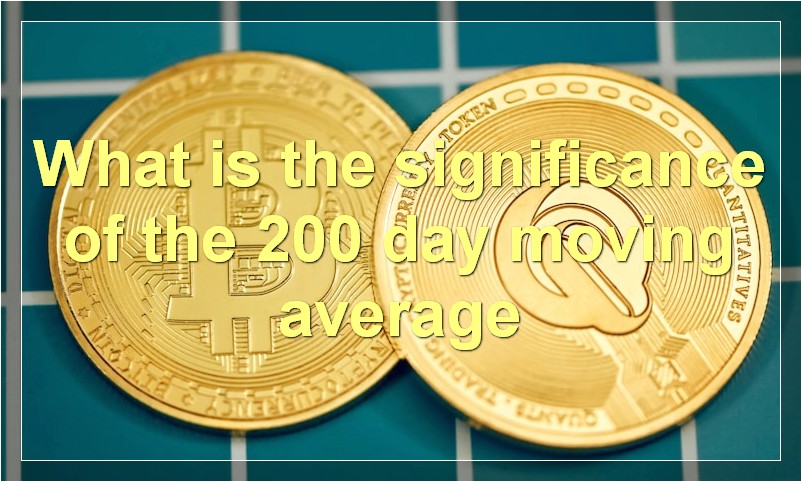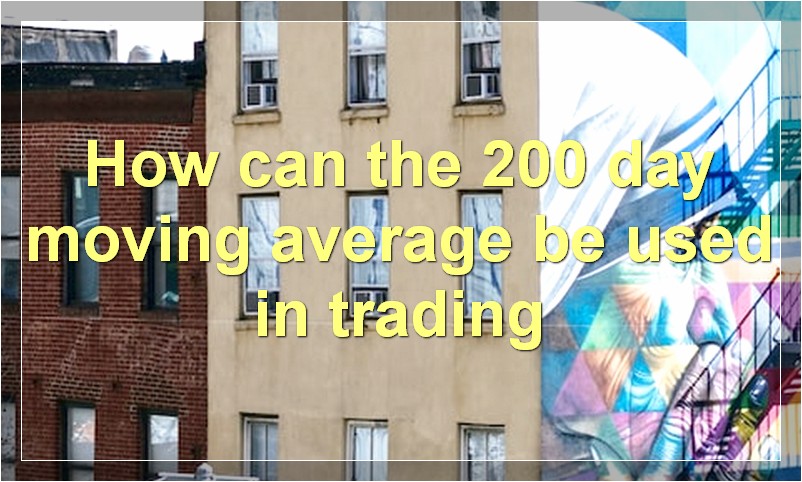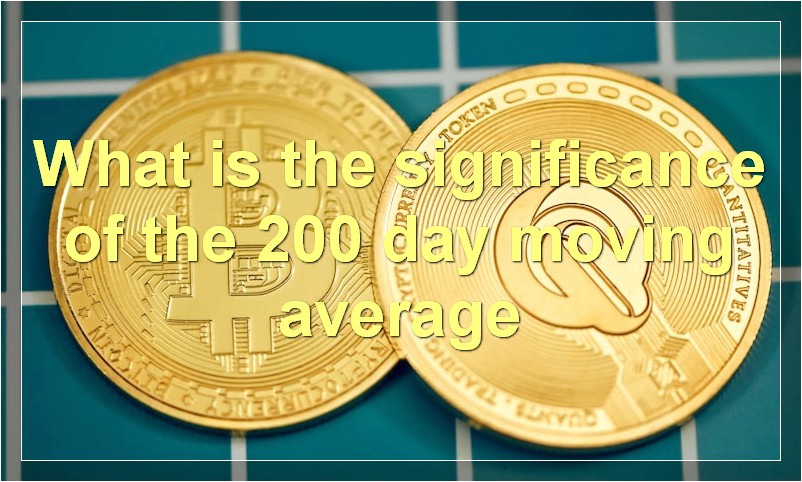Use the 200 day moving average to your advantage in the stock market.
What is the 200 day moving average
When it comes to technical analysis, there are a lot of different indicators that traders can use to try and predict where the market is headed. One of the most popular indicators is the 200 day moving average.
So, what is the 200 day moving average? Basically, it is a measure of the average price of a security over the last 200 days. Traders often use this indicator to help them identify trends in the market.
There are a few different ways that traders can use the 200 day moving average. One way is to simply look at the price of a security and see if it is above or below the 200 day moving average. If it is above, then that is generally seen as a bullish sign, and if it is below, it is generally seen as a bearish sign.
Another way that traders can use the 200 day moving average is to take a look at how the security is trading in relation to its 200 day moving average. If it is trading above its 200 day moving average, then that is generally seen as a bullish sign. On the other hand, if it is trading below its 200 day moving average, then that is generally seen as a bearish sign.
There are a lot of different factors that traders need to consider when making their decisions. However, the 200 day moving average is definitely one indicator that they should keep an eye on.
What is the significance of the 200 day moving average

The 200 day moving average is a technical indicator that is used by many traders to help them make decisions about when to buy and sell stocks. The 200 day moving average is simply the average price of a stock over the last 200 days. Many traders believe that the 200 day moving average is a good measure of a stock’s long-term trend, and they use it to help them make decisions about when to buy and sell.
How is the 200 day moving average calculated
The 200 day moving average is calculated by adding the closing prices of the past 200 days and then dividing by 200. This average is used to smooth out volatility and to help provide a longer-term trend for a stock. When the price of a stock is above its 200 day moving average, it is generally considered to be in an uptrend. Below the 200 day moving average, and it is generally considered to be in a downtrend. Many traders use the 200 day moving average as a key technical indicator.
What are the benefits of using the 200 day moving average
There are a number of benefits to using the 200 day moving average when trading stocks. First, it is a long-term trend indicator that can help you identify the overall direction of the market. Second, it can help you spot potential support and resistance levels. Third, it can help you time your entries and exits from trades. Finally, it can help you manage your risk by providing a clear stop-loss level.
What are the drawbacks of using the 200 day moving average
There are a few drawbacks to using the 200 day moving average as a trading strategy. First, the 200 day moving average is a lagging indicator, meaning it will only tell you what has happened in the past and not what is happening in the present. This can be problematic because by the time you see that the 200 day moving average is going down, the stock may have already started to drop. Second, the 200 day moving average only works well in trending markets. If the market is range-bound or choppy, the 200 day moving average will generate a lot of false signals. Finally, the 200 day moving average is just one tool and should not be used as the sole basis for making trading decisions.
How can the 200 day moving average be used in trading

The 200 day moving average is a popular technical indicator that is used by many traders to help them make decisions about when to buy and sell stocks. There are a few different ways that the 200 day moving average can be used, but one of the most common ways is to use it as a trend following indicator.
If the stock market is in an uptrend, then the 200 day moving average will be rising as well. This means that it can be used as a buy signal, telling traders when to buy stocks. On the other hand, if the stock market is in a downtrend, then the 200 day moving average will be falling. This can be used as a sell signal, telling traders when to sell their stocks.
Another way that the 200 day moving average can be used is as a support or resistance level. If the stock market is trading above the 200 day moving average, then it is likely that there will be some form of support at this level. This means that if the stock market starts to fall, it is likely to find support at the 200 day moving average. Similarly, if the stock market is trading below the 200 day moving average, then it is likely that there will be some form of resistance at this level. This means that if the stock market starts to rise, it is likely to find resistance at the 200 day moving average.
The 200 day moving average can be a helpful tool for traders, but it is important to remember that it is just one indicator. It should not be used on its own, but rather in combination with other technical indicators and fundamental analysis in order to make more informed decisions about when to buy and sell stocks.
What are some common mistakes traders make when using the 200 day moving average
There are a few common mistakes that traders make when using the 200 day moving average. The first is failing to properly calibrate the indicator. Many traders will use the default settings for the 200 day moving average, which is usually set at 20. However, this setting is not optimal for all markets and trader should calibrate it to fit their own trading style and the market they are trading. The second mistake is using the 200 day moving average as a lagging indicator. While the 200 day moving average can be used to identify trends, it should not be used as a sole tool for making trading decisions. Traders should also use other indicators to confirm trends identified by the 200 day moving average. Finally, many traders fail to account for the volatility of the markets when using the 200 day moving average. The 200 day moving average is a lagging indicator, so it will smooth out market volatility. This means that traders need to account for market volatility when using the 200 day moving average to make sure they are not getting false signals.
How can the 200 day moving average be used to spot trends
The 200 day moving average is a popular tool used by traders to spot trends. By taking the average of a stock’s price over the past 200 days, traders can get a good idea of where the stock is headed. If the stock is above its 200 day moving average, it is generally considered to be in an uptrend. If the stock is below its 200 day moving average, it is generally considered to be in a downtrend.
What are some other uses for the 200 day moving average
The 200 day moving average is a technical indicator that is used by traders to identify the long term trend of a security. It is also used by investors to help smooth out the volatility of a security and to provide a longer term perspective. Additionally, the 200 day moving average can be used to generate buy and sell signals.
Is the 200 day moving average always accurate
The 200 day moving average is a popular tool for investors and traders to gauge the long term trend of a stock or index. However, like all technical indicators, it is not always accurate. In fact, there are times when the 200 day moving average can give false signals.

